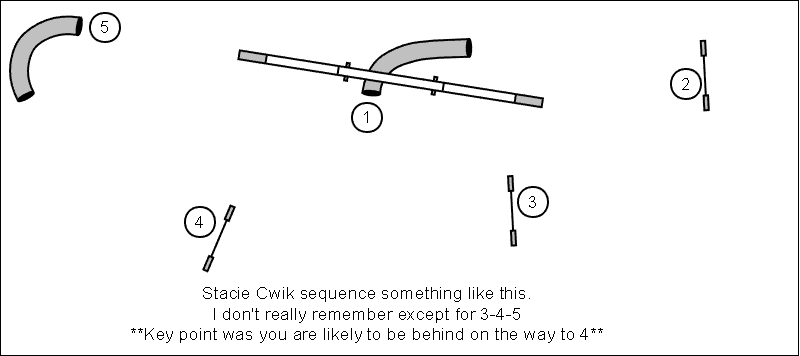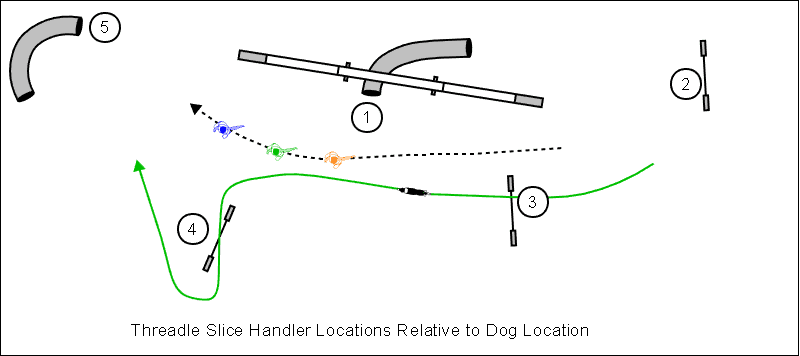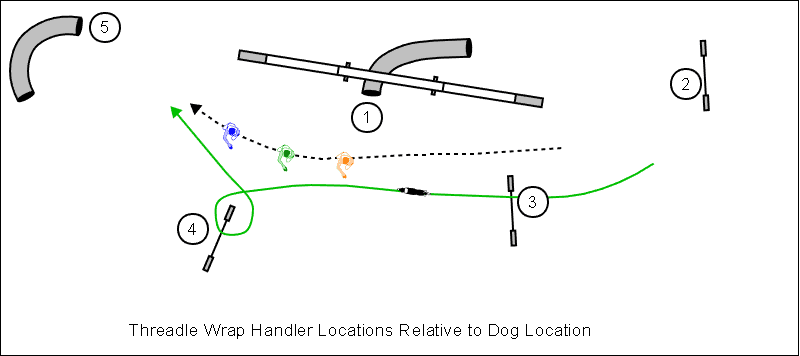Are You Training Enough Threadle Handler Locations?
16 Jan 2023
A few weeks ago, I was running a practice sequence with Spark in our weekly Stacie Cwik class at Flint Creek Dogs and it really highlighted that my location, relative to the jump, dramatically influenced whether or not he would take the jump with my physical and verbal threadle Mary Ellen Barry on Threadle HandlingThe Connection Between Threadles and Back SidesTraditional Threadle HandlingSingle Sided Threadle HandlingThreadle Sequence cues. And that makes perfect sense!
But, I also want Spark’s threadles to be as independent as possible.
So I’m posting this quick note so you can think about how independently your threadles are trained.
Here’s what I recall of Stacie’s sequence:

For this discussion the course dimensions don’t matter. Also, you are going to handle jump 4 with your dog on your left and handle it as a threadle. Yes, you could cross on the approach and push your dog to the back side Handling the Quad Back Side - Patrick Bucher Course/VideoThe Connection Between Threadles and Back SidesBack Side/Back Side JumpBack Side of Jump Handling Combinations - Video, but I want to talk about proofing your dog’s understanding of your threadle cues/handling.
If you decide to handle jump 4 as a threadle slice your path and your dog’s path might look something like this:

FWIW, I reach back and drop my dog side arm to cue a threadle slice. Again, for this discussion it doesn’t matter how you cue your dog. What I found with Spark, in this sequence and others, is:
- if I’m at the middle (green handler) when he’s at the point shown he’ll easily execute the threadle slice.
- if I’m on the approach further from the jump (right/orange handler) he’ll take the front side.
- if I’m further ahead on the landing side of the jump (left/blue handler) he’ll run by the jump and come with me.
So there is a sweet spot on either side of the jump (but more to the take off side) where he understands I want the threadle slice and he’ll take it.
If you decide to handle jump 4 as a threadle wrap your path and your dog’s path might look something like this:

For the threadle wrap the story is much the same:
- if I’m at the middle (green handler) when he’s at the point shown he’ll easily execute the threadle wrap.
- if I’m further away on the approach to the jump (right/orange handler) he’ll take the front side.
- if I’m further ahead on the landing side of the jump (left/blue handler) he’ll either run by the jump and come with me or he’ll treat it as a threadle slice.
As you might expect, our “sweet spot” extends further in front of the jump than for the threadle slice.
Spark is still a youngster so I’ll add some practice sessions where I am both more ahead and more behind to proof his understanding of both threadle slices and wraps.
Snap! is more experienced and has a wider range of my locations where he’ll understand my slice/wrap cues.
So, if you want to be successful with threadle wraps and slices I urge you to play around with your location relative to the jump (both before and after the jump). How far before and after a jump can you cue a threadle wrap or slice and have your dog be successful? Work on expanding that distance little by little. You don’t want to be in a situation where you have to be close to the jump to be successful.
I’m sure you are already working on varying your lateral distance from the jump too!(??)
If you enjoyed this article won't you please:  Thanks!
Thanks!
